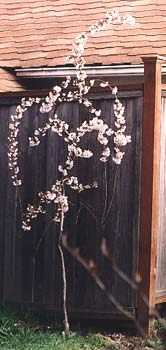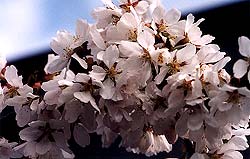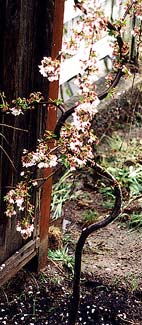 Snow Fountain White Weeping Cherry
Snow Fountain White Weeping Cherry
"I think I have never been so exalted
As I am now by you,
O frost bitten blossoms,
That are unfolding your wings
From out the envious black branches."
-William Carlos Williams
(1883-1963)
(1883-1963)
Very likely the goofiest & least naturalistic of all the plants I ever installed in our yards was this Snow Fountain Weeping Cherry (Prunus subhertella 'Snofozam Pendula'). It's a hybridized, grafted & tortured Weeping Higan Cherry, forced into such an odd shape that we used to call it our Doctor Seuss Tree. The nurseries call it Snow Fountain 'Twister' or 'Contorted.' The angle of the top photograph doesn't capture the "S" shape of the main trunk, which a week or so later I photographed from up the path on the right; the lower left-hand photo shows the shape of the tortured trunk.
In spring 2002 this little specimen was about 9 feet tall at the uppermost turn of the leader. It should have grown rapidly to 15 feet then given more of its energy to putting on girth. The upright natural form of the tree reaches 40 feet, whereas the natural weeping form is rarely more than 25 feet high & wide. The contorted doesn't get even as big as that, but it can still become a substantial tree in time.
Unfortunately, in the summer of 2002, our young specimen began to "bleed" heavily from the graft, which is usually evidence of fungal disease. It went downhill rapidly. As I think back, we've only ever lost two trees, & frankly, if we had to lose a second one, this was the one I was bound to miss least. Although I had sorted through hundreds of these artificially twisted trees at a half-dozen different nurseries before settling on one I liked at the time, I really can't fathom how I fell for it.
If it were true that "bad thoughts" can kill plants (as some people superstitiously believe; see the article on Telepathic Plants), then I would fear I'd killed it when I started wondering, almost as soon as I planted it, "Whatever possessed me to buy this silly thing?" I love weepers & I love naturally twisting cultivars, but this tree was always somehow "wrong" for naturalistic gardening, & it had to have been the child in me that made this aesthetically inappropriate choice. I think I was imagining how it would age; as an older tree with a severe bend, it might someday have been quite interesting, but as a sapling it just looked like a mass-produced "product." Had it thrived, it would eventually have required careful annual pruning to preserve the rounded shape to the fountaining limbs, but new limbs would have wept naturally. So it was the plan to let the limbs go a bit wild so that it wouldn't look entirely fakey. If permitted, new limbs could grow long enough to sweep the ground, & the strongly dangling branches would partially obscure the unnatural twists of the main limbs, resulting in time in a very pretty & less manufactured-looking oddity.
 But when the graft started spewing sap & my attempts to treat it for fungus had no beneficial effect, I was less saddened than I would've been if it'd been any other tree.
But when the graft started spewing sap & my attempts to treat it for fungus had no beneficial effect, I was less saddened than I would've been if it'd been any other tree.I don't quite know why it should've been so susceptible to disease & die so swiftly, as I had researched it fully & tried to provide for it adequately. This cherry prefers sun & ours got plenty, but it would've done fine with some shade too. We did have a stretch of record-hot summer days that stressed even some of the older things, so the cherry probably was not established well enough to cope.
 It wasn't without its charms. The double-flowers shown in the right-hand photograph were showy & pleasant. During the two springs we had this tree, I did rather like it when in bloom. The reason the variety is called 'Snofazam' or Snow Fountain is because the blooms are so vibrantly white in their cascade. The blooming begins late March & continues through early April, not a long time but even so, longer than most ornamental cherries, with a solid two weeks before the blossoms fall en masse. This page's photos were taken in an April, but a couple March photos could've been used if I'd gotten the lighting better.
It wasn't without its charms. The double-flowers shown in the right-hand photograph were showy & pleasant. During the two springs we had this tree, I did rather like it when in bloom. The reason the variety is called 'Snofazam' or Snow Fountain is because the blooms are so vibrantly white in their cascade. The blooming begins late March & continues through early April, not a long time but even so, longer than most ornamental cherries, with a solid two weeks before the blossoms fall en masse. This page's photos were taken in an April, but a couple March photos could've been used if I'd gotten the lighting better.When the blooms begin, the tree has almost no leaves, but by the time the blooms are losing their brightness, the leaves are well along.
Ours did not sucker, but many do, & since the rootstock is a normal upright Higan cherry, suckers should be removed, for the rootstock & lower trunk is not a weeper. The variety does produce a few cherries which are small & start red, maturing to black, but are hidden by the leaves so could go unnoticed, & not particularly meaty so not regarded edible; they might as well be left on the branches for the birds.
In the aftermath of the loss of this young tree, I left its location empty of any other plants in case there was indeed a fungus. I removed some of the soil to discard on the roadside, & filled the hole with humousy soil, but adhered to a plan to leave that spot unplanted for at least a year. The dead tortured cherry I removed to the compost area & hung on a wall to continue drying. It will not go entirely to waste as the winding trunk, cut loose of the rootstock, will eventually be used as the center post of a home-made trellis.